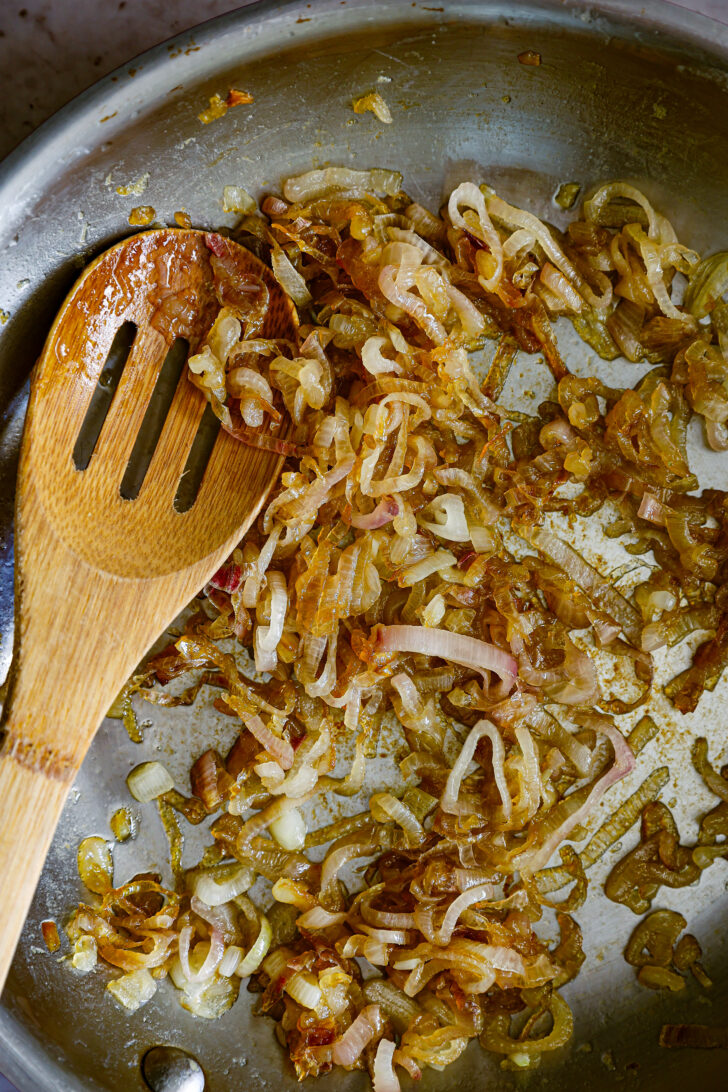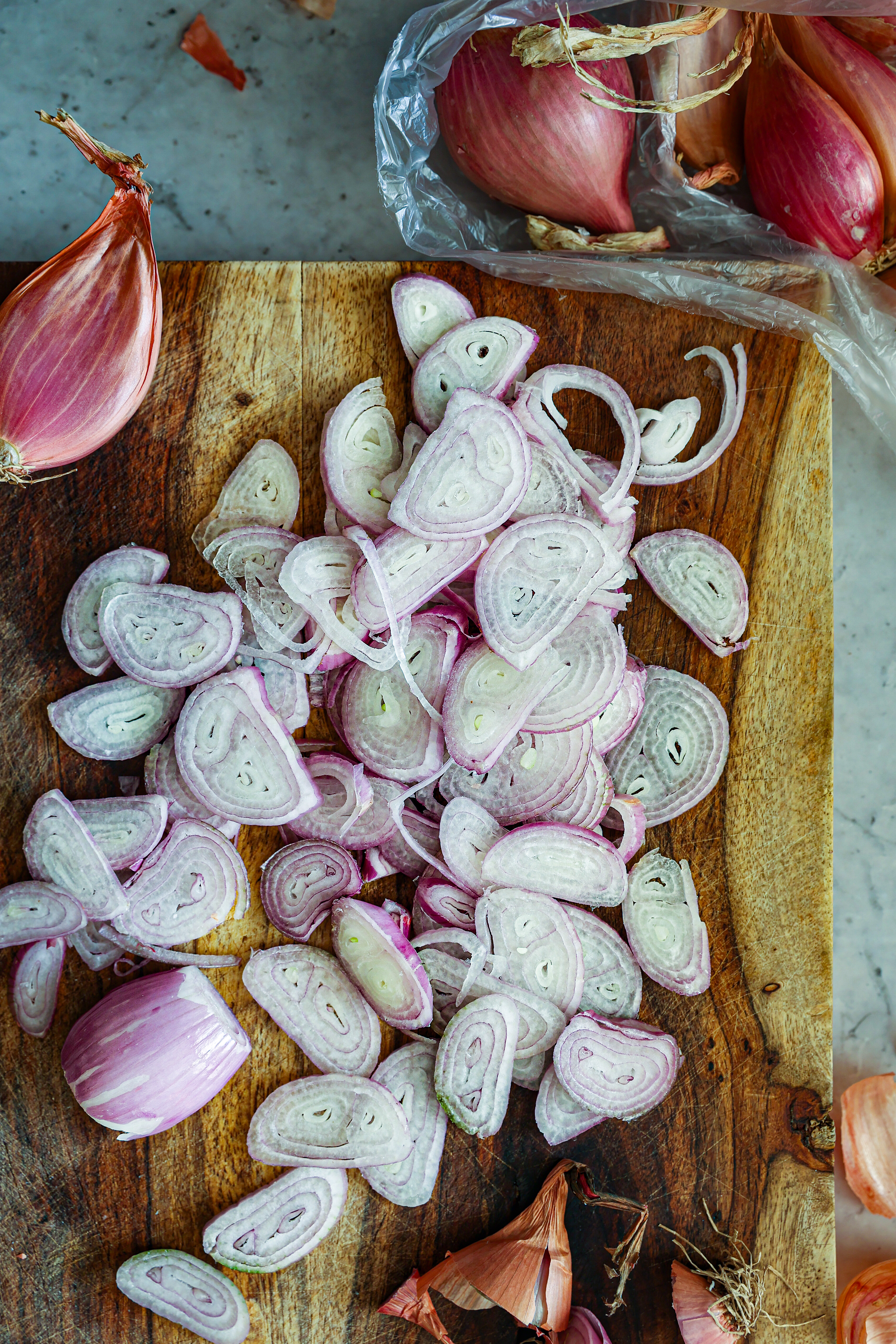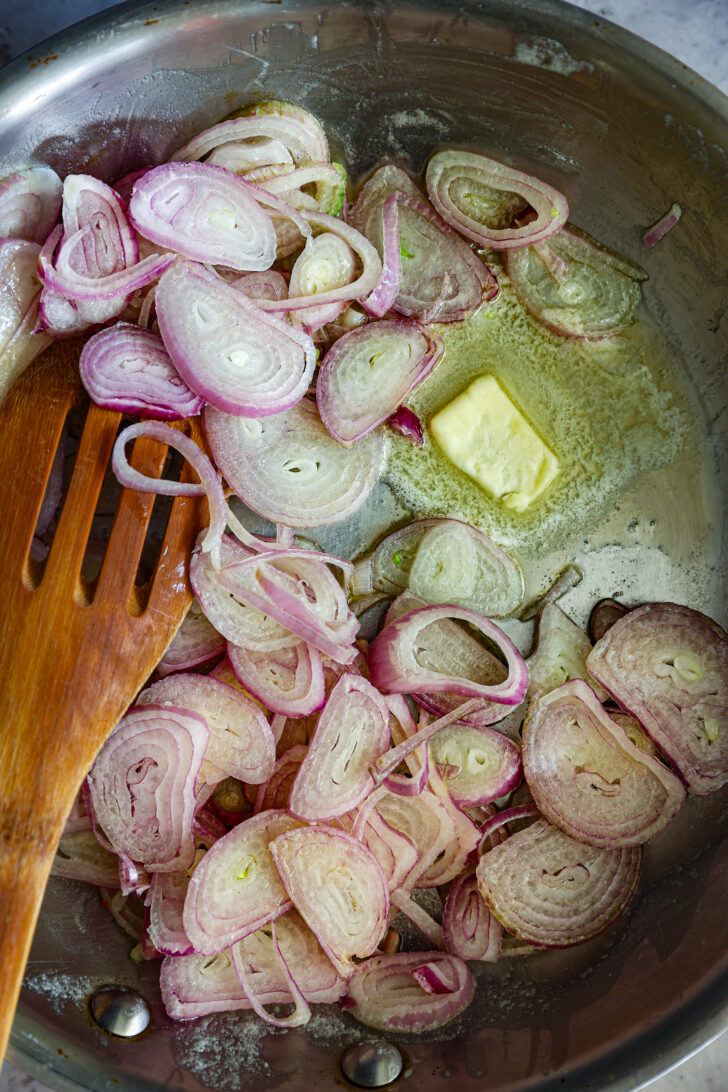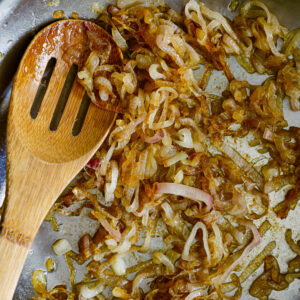Caramelized Shallots
You know what’s seriously underrated? Caramelized shallots. Sauté them in some butter, let them hang out on low heat, and just forget about them for a while (well not exaclty, but almost!). Then suddenly, they’re golden and sweetᅳhonestly, you’re going want them on everything. Personally, I love adding them to pretty much anythingᅳsalads, pastas, you name it. Trust me, once you try them, you’ll get it.

Ever given caramelized shallots a try? Honestly, they’re way better than you’d expect.
No? Well… you’re in for something special today, let me tell you. Just toss ’em in some butterᅳreal simpleᅳkeep that heat low. And, before you even think about itᅳboom! They’re all golden, soft, kinda magical right?
I’ve honestly caught myself eating them straight from the panᅳno joke, couldn’t stop. You’d probably do the same (don’t judge me).
Honestly, once you try them, you’ll seeᅳthey just make everything better in the simplest way. Not exaggerating.
Try it once – at least! Speaking of… why do onions get all the hype anyway? Shallots are the real MVP. Just saying.
You can learn a lot more about caramelization over at my Culinary Chemistry Post!!
If you want to skip ahead, you can just Jump to Recipe
Why this works
- Simple Ingredients, Big Flavor: Okay, so shallots? They’ve already got that subtle, sweet vibe, but once you caramelize themᅳwhoa, they’re on a whole new level. I’m talking sweet, savory, rich… they just make everything better. Throw them in anythingᅳwell, almost anything. As a side note, there is an ice cream place in Bar Harbor (Bah Habah) that sells Lobster Ice Cream. Ya, its not good.
- Butter’s Role: And butter? Who does not love butter?! It’s not just there for flavor (though, yeah, it adds plenty). It coats the shallots, helps them cook nice and slow, getting them all tender and golden.
- Low and Slow Cooking: Seriously, just take your timeᅳno need to rush this. Rushing? Not an option. Let those sugars caramelize, and before you know itᅳboom! You’ve got golden, tender shallots with that deep, almost smoky sweetness
- Versatility in Use: And the best part? They go with everything. Add them to a sandwich, stir them into a creamy pastaᅳheck, sometimes I just eat them straight from the pan. I’m not even sorry. 🙂
- Technique Over Complex Equipment: Forget the gadgetsᅳyou’re only going to need a pan, a wooden spoon… and maybe a bit of patience (but hey, no rush, right? ).
- Salt as a Flavor Enhancer: How big of a deal can a pinch of salt really be? Turns out, pretty huge. It pulls moisture right out and keeps the sweetness balanced. Sometimes, it really is about those tiny details.

Remember, you can skip ahead Jump to Recipe
Take It to the Next Level
- Herb Infusion: Got thyme? (See what I did there? 🙂 Or maybe a bay leaf? Toss one in while the shallots are cooking. It’ll give them that little herbal kickᅳsubtle, but trust me, you’ll notice.”
- Variations in Butter: Try mixing butter with a splash of olive oil. I know it sounds a bit unconventional, but it keeps the butter from burningᅳand the extra flavor is out of this world!
- Wine Deglazing: “Once your shallots are looking golden and delicious, splash in a bit of white wine. Or… Try balsamic vinegar insteadᅳit adds a fun twist! That extra flavor kick? You’re going to love it!
- Storage Tips: “Storing these beauties? Just make sure they cool off before you tuck them into an airtight container. They’ll keep in the fridge for up to a weekᅳif they last that long, that is.”
- Serving Suggestions: These shallots are bursting with flavor, and they work with almost anything! Toss them over a juicy steak or mix them into creamy mashed potatoes for an extra kick.Tried them on pizza yet? They bring such a great punch. And if you’re feeling adventurous, pile them onto a burgerᅳyour family will love it!”
- Sweet Twist: Stir in a bit of brown sugar while they cookᅳit adds an unexpected layer of flavor. More flavor = good!

Faq’s
Definitely! Onions work, for sureᅳjust remember, they’ve got more bite than the mellow sweetness of shallots. Totally different vibe, but they get the job done.
Slice them nice and thinᅳabout 1/8 inch. That way, they’ll cook evenly and caramelize without going too fast.
Lower the heat right away. Caramelizing takes its sweet time, so if they’re burning, dial it down to low.
Sure thing! Pop them in an airtight container, and they should be fine in the fridge for a weekᅳmaybe a little longer! Whenever you’re ready for them (craving them? ), just grab them, and you’re good to go!
Of course! Olive oil or your favorite plant-based butter works just as well.
Equipment Needed
- Cutting Board and Knife: Knife sharp? Check. That cutting board better not wobbleᅳshallots demand precision, but hey, we’re not building a rocket here.
- Skillet or Frying Pan: A sturdy, heavy-bottomed skillet is your best friend here. It keeps the heat consistent, so nothing burns before it caramelizes.
- Spatula or Wooden Spoon: You’ll want something to gently stir the shallots, keeping them from sticking and ensuring they cook just right.
- Measuring Spoons: Handy for measuring out oil, butter, or whatever extra flavors you’re adding in.
- Stove: Set your stove to low or MAX mediumᅳno cranking it up! Slow and steady wins the game here.
- Optional Splash of Liquid: A bit of broth, wine, or water can go a long way in adding depth when deglazing the pan.

Caramelized Shallots
Ingredients
- Shallots (quantity as needed, thinly sliced)
- Butter (enough to generously coat the bottom of your pan, typically 2-4 tablespoons)
- Salt (to taste)
Instructions
- Begin by peeling your shallots and slicing them thinly. This ensures even cooking and caramelization.
- Place your skillet on the stove over medium-low heat. Add the butter, allowing it to melt slowly. The goal is to coat the bottom of the skillet with melted butter without letting it brown or burn.
- Once the butter has melted, add your thinly sliced shallots to the skillet. Stir them gently to ensure they are evenly coated with the butter.
- Sprinkle a pinch of salt over the shallots. Salt helps to draw out moisture, aiding in the caramelization process.
- The key to perfect caramelization is patience. Allow the shallots to cook slowly, stirring occasionally. You’re looking for a gradual transformation, where the shallots soften and their color turns to a golden brown. This process can take anywhere from 15 to 30 minutes, depending on the quantity of shallots and the exact heat of your stove.
- Periodically stir the shallots to prevent them from sticking to the pan and to ensure even caramelization. Adjust the heat if you find them browning too quickly.
- The shallots are done when they are a deep golden color and have a sweet, rich aroma. They should be soft but not mushy.
- You can use the caramelized shallots immediately as a garnish, a flavor enhancer in dishes, or let them cool and store them in an airtight container in the refrigerator for a few days.
Notes
Tips
- Low and Slow: The key to caramelization is low heat and patience. High heat will cause the shallots to burn rather than caramelize.
- Consistency: Ensure the shallots are sliced uniformly for even cooking.
- No Crowding: If you’re cooking a large batch, avoid crowding the pan. Cook in batches if necessary to ensure each shallot slice has room to caramelize.
